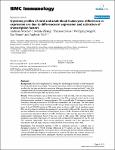Cytokine profiles of cord and adult blood leukocytes: differences in expression are due to differences in expression and activation of transcription factors
Nitsche, Andreas
Zhang, Meixia
Clauss, Theresa
Siegert, Wolfgang
Brune, Kay
Pahl, Andreas
Background: Stem cell transplantation as therapy for hematological disorders is often hampered by severe graft-versus-host-disease. This may be reduced by umbilical cord blood transplantation, an effect that has been attributed to qualitative differences between neonatal and adult T cells. We compared levels of secreted proteins and cytokine mRNA induced in cord blood leukocytes (CBL) and adult blood leukocytes (ABL) by various stimuli. Results: While interleukin-2 (IL-2) levels were similar in CBL and ABL, there was less induction of the Th1 cytokine interferon-γ in CBL. Production of the Th2 cytokines IL-4, IL-5, and IL-13 and the hematopoietic cytokine IL-3 was much lower in CBL versus ABL after T-cell receptor-mediated stimulation, whereas production of GM-CSF was comparable in the 2 cell types. The lower levels of Th1 and Th2 cytokines were maintained in CBL during a 4-day time-course study, while after 12 hours IL-3 and GM-CSF reached in CBL levels similar to those in ABL. For all cytokines except IFNγ, the IC50 values for inhibition by cyclosporin A were similar in ABL and CBL. In contrast, there was less expression and activation of transcription factors in CBL. Activation of NF-κB by TPA/ ionomycin was detected in ABL but not CBL. Furthermore, there was less expression of the Th subset-specific transcription factors T-bet and c-maf in CBL versus ABL, whereas GATA-3 expression was similar. Expression of T-bet and c-maf correlated with expression of the Th1 and Th2 cytokines, respectively. Time course experiments revealed that T-bet expression was stimulated in both cell types, whereas c-maf and GATA-3 were induced only in ABL. Conclusion: The diminished capability of CBL to synthesize cytokines is probably due to decreased activation of NF-κB, whereas differences in Th subsets are due to differences in regulation of Th lineage-specific transcriptions factors. We propose that the reduced incidence and severity of GvHD after allogeneic transplantation of umbilical CB cells is due to lesser activation of specific transcription factors and a subsequent reduction in production of certain cytokines.
No license information
Related Items
Show related Items with similar Title, Author, Creator or Subject.
-
2010-05-01ZeitschriftenartikelDifferential expression of human endogenous retrovirus K transcripts in primary human melanocytes and melanoma cell lines after UV irradiation. Reiche, Janine; Pauli, Georg; Ellerbrok, HeinzHuman endogenous retroviruses (HERVs) are discussed as causative agents of various diseases including cancers. Expression of endogenous retroviral sequences can be induced by ultraviolet (UV) light, which is also considered ...
-
2009-02-25ZeitschriftenartikelCross-talk between type three secretion system and metabolism in Yersinia. Schmid, Annika; Neumayer, Wibke; Trülzsch, Konrad; Israel, Lars; Imhof, Axel; Roessle, Manfred; Sauer, Guido; Richter, Susanna; Lauw, Susan; Eylert, Eva; Eisenreich, Wolfgang; Heesemann, Jürgen; Wilharm, GottfriedPathogenic yersiniae utilize a type three secretion system (T3SS) to inject Yop proteins into host cells in order to undermine their immune response. YscM1 and YscM2 proteins have been reported to be functionally equivalent ...
-
2013-08-07ZeitschriftenartikelThe Transmembrane Protein of the Human Endogenous Retrovirus - K (HERV-K) Modulates Cytokine Release and Gene Expression Morozov, Vladimir; Thi, Viet Loan Dao; Denner, JoachimNumerous copies of endogenous retroviruses are present in the genome of mammals including man. Although most of them are defective, some, e.g., the human endogenous retroviruses HERV-K, were found to be expressed under ...

